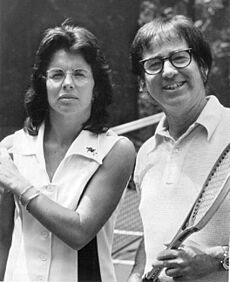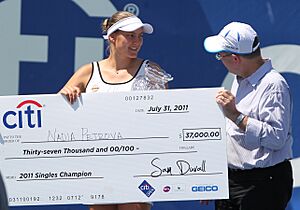Women's Tennis Association facts for kids
 |
|
| Sport | Professional tennis |
|---|---|
| Abbreviation | WTA |
| Founded | June 1973 |
| Location | St. Petersburg, Florida, U.S. |
| Chairman | |
| CEO | |
| Official website | |
| Current season: 2025 WTA Tour | |
The Women's Tennis Association (WTA) is the main group that organizes professional tennis for women. It runs the WTA Tour, which is a worldwide series of tennis tournaments for women. The WTA was started to make women's tennis better and fairer. Its main office is in St. Petersburg, Florida, in the U.S. It also has offices in London, UK, and Beijing, China.
The Women's Tennis Association was created in June 1973 by the famous tennis player Billie Jean King. Its beginnings go back to a special tournament in 1970 called the 1970 Houston Women's Invitation. This event was put together by Gladys Heldman and sponsored by Joe Cullman. It happened on September 23, 1970, in Houston, Texas. Rosie Casals won this very first tournament.
When the WTA started, Billie Jean King was one of nine players who formed the group. They were known as the "Original 9." These players included Julie Heldman, Valerie Ziegenfuss, Judy Dalton, Kristy Pigeon, Peaches Bartkowicz, Kerry Melville Reid, Nancy Richey, and Rosie Casals. Today, the WTA has more than 2,500 players from almost 100 countries. They compete for over $146 million in prize money.
Contents
How Women's Tennis Became Professional
Professional tennis, where both amateur and professional players could compete, began in 1968. This was called the Open Era. In the late 1960s, Billie Jean King was a top player. She noticed that men tennis players often received much more prize money than women. For example, at Wimbledon in 1968, the men's prize money was much higher than the women's.
At the start of the Open Era, there were two main professional tennis groups. One was only for men. Billie Jean King and other women players joined another group called the National Tennis League (NTL). They played in big tournaments like the US Open and Wimbledon. But they also organized their own events. The International Tennis Federation (ITF) sometimes stopped these women from playing in certain tournaments because they were professional.

By the 1970s, the difference in pay between men and women tennis players grew even bigger. Billie Jean King said that everyone involved in tennis was making more money except the women. In some tournaments, men were paid 5 to 12 times more than women.
Billie Jean King and Cynthia Starr wrote in their book that women had little control in the sport. Men owned and promoted the tournaments. Their sympathies were often with the male players. A low point came before the 1970 US Open. A tournament announced a 12-to-1 pay difference between men and women. This made the top nine women players decide to take a stand for equal pay. These women became known as the "Original 9."
Instead of playing in that tournament, the Original 9 wanted to create their own. They contacted Gladys Heldman, who published World Tennis Magazine. Heldman helped them set up a tournament in Houston. This event was a success. Heldman then got financial support from Philip Morris, a company that made cigarettes. They sponsored a new series of tournaments for women in 1971. This series was called the Virginia Slims circuit.
The International Lawn Tennis Federation (ILTF) started removing women's competitions from some tournaments. But the new women's circuit grew. It eventually became the WTA Tour in 1995. This circuit had 19 tournaments, mostly in the United States. The total prize money was over $300,000.
In 1973, the US Open became the first major tennis tournament to give equal prize money to women and men. The Australian Open followed in 1985. The French Open started offering equal prize money for champions in 2006. By 2007, both Wimbledon and the French Open also offered equal prize money. This meant all four major tournaments paid women and men equally.
The WTA Tour sold the rights to show all its tournaments on television. This helped many people around the world watch women's tennis. In the 1980s, tennis became very popular. It moved from private clubs to public parks and big arenas. Women's tennis grew to be almost as big as men's tennis. The women did this themselves, which is why their organization is still independent today.
The WTA Tour Today
The WTA was officially founded at a meeting in London in 1973. In 1975, the WTA signed its first television deal with CBS. This helped the WTA financially. Later, other companies like Colgate and Avon sponsored the women's tennis circuit. In 1979, Avon offered the largest prize money for a single tournament in WTA history: $100,000.
In 1983, all the different women's tennis circuits joined together. Virginia Slims became the main sponsor of the entire WTA Tour. This sponsorship lasted for many years. Some people criticized this sponsorship because it connected a tobacco brand with healthy athletes.
In 1977, women's tennis became the first professional sport to allow transgender women to compete. The WTA now has official rules for transgender players.
In 1984, the Australian Open also offered women equal prize money. After a long campaign, all four major tournaments (Grand Slams) offered equal prize money by 2007.
In 1995, the WTA Players Association and the Women's Tennis Council joined to form the WTA Tour we know today.
Growth and Milestones
The WTA circuit continued to grow over the years. In 1971, Billie Jean King was the first female athlete to earn over $100,000 in one year. Chris Evert was the first woman to earn over $1,000,000 in her career by 1976. By 1980, more than 250 women were playing tennis professionally. The circuit had 47 events around the world, offering $7.2 million in prize money. These new financial chances helped women's sports grow a lot.
In 1982, Martina Navratilova was the first to earn over $1,000,000 in a single year. By 1984, her earnings for one year were over $2 million. In 1997, Martina Hingis earned over $3 million in a single year. Then, in 2003, Kim Clijsters earned over $4 million.
In 2006, Venus Williams and the WTA worked hard for equal prize money at the French Open and Wimbledon. Both tournaments agreed in 2007. This allowed Justine Henin, who won the French Open in 2007, to earn over $5 million that year. She was the first woman in sports to do this. In 2009, Serena Williams earned over $6.5 million in one year. By 2012, both Serena Williams and Victoria Azarenka earned over $7 million in a single season. In 2013, Serena Williams earned over $12 million in one year.
WTA Leadership
Jerry Diamond was the executive director of the WTA from 1974 to 1985. He helped make important business deals with sponsors like Avon and Toyota.
Larry Scott became the chairman and CEO of the WTA in 2003. He helped get the biggest sponsorship deal in women's sports history with Sony Ericsson, worth $88 million over six years. Larry Scott left the WTA in 2009.
Stacey Allaster became the new chairman and CEO in 2009. She was named one of the "Most Powerful Women in Sports" by Forbes Magazine. She helped the WTA grow a lot and got media deals that helped fans watch women's tennis all over the world. She also worked hard for gender equality. She retired in 2015.
On October 5, 2015, Steve Simon became the new WTA chairman and CEO. In December 2021, the WTA, led by Steve Simon, stopped its operations in China and Hong Kong for a while. This was due to concerns about a player named Peng Shuai. The boycott ended in 2023.
In March 2022, a medical technology company called Hologic became a main sponsor of the WTA Tour.
WTA Tournaments

The WTA Tour includes many different types of tournaments around the world. These events offer various amounts of prize money and ranking points.
- WTA 125 tournaments are smaller events. In 2018, there were ten such tournaments. They offered prize money ranging from $125,000 to $150,000.
- Players can also earn ranking points at tournaments organized by the International Tennis Federation (ITF). These are called the ITF Women's Circuit events. They offer prize money from $15,000 to $100,000.
Players' Council
The Players' Council is a group of eight players who are part of the WTA board of directors. They speak for the players and help with their concerns. They discuss things like the tennis schedule and other issues.
2024–25 Players' Council
- Top 20 Ranking: Victoria Azarenka, Caroline Garcia, Madison Keys, Jessica Pegula, Maria Sakkari
- 21–50 Ranking: Donna Vekić
- 51–100 Ranking: Daria Saville
- Doubles Players: Gabriela Dabrowski
- 101+ Ranking: Aleksandra Krunić
WTA Rankings
The WTA keeps track of how well players perform using a ranking system. These rankings help decide which players can enter tournaments and how they are seeded.
- WTA Singles Ranking
- WTA Doubles Ranking
See also
 In Spanish: Asociación de Tenis Femenino para niños
In Spanish: Asociación de Tenis Femenino para niños
- WTA Tour
- Association of Tennis Professionals (ATP, for men's tennis)
- List of tennis tournaments
- List of WTA number 1 ranked players
- Women's sports
- WTA Awards
- WTA Challenger Series
- WTA Tour Championships
- WTA Tour records
- Tennis Integrity Unit
- WTA rankings






